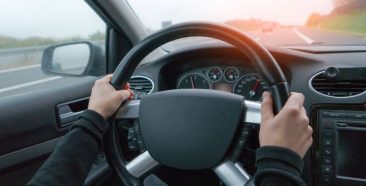
While night driving can be a risky activity almost anytime, throw in some hazardous weather conditions and the danger increases even more. Getting behind the wheel at night during the winter months can often result in some white knuckle trips, no matter how short. Whether you’re dealing with high winds, heavy rain, or snow – if you’re driving at night or even early morning – you have to adjust your driving accordingly, or factors like decreased visibility, along with treacherous conditions, can multiply your odds of an accident. And, that could only lead to one thing – higher auto insurance rates.
Why Is Night Driving Dangerous?
There’s absolutely nothing wrong with being a little extra cautious in order to keep you safer against the dangers of driving at night. Your life, the lives of your family members, and those of other drivers could depend on it. If you normally don’t believe it until you see it – here are a few facts for you to digest: according to the National Safety Commission (NSC). Despite nighttime driving accounting for only 23 percent of vehicle miles traveled during the day, over 50 percent of all recorded fatalities for vehicle occupants 16 years of age and older occur between the hours of 6 p.m. and 6 a.m. And, those aren’t even winter night driving statistics.
Of course, the more awareness you have, the better off you’ll be. But, this isn’t like finding the cheapest auto insurance. It’s important to take the hazards of night driving seriously, so you don’t become the victim of an avoidable accident.
Tips for Night Driving Safety
Now that we have a good idea of why taking extra precautions while night driving is important, let’s get right to it: how can you keep yourself and your family safe? We’ve prepared an easy to follow list of recommendations to help you on those late drives. Below are a few bits of information you may want to consider to lower your risk factors.
1. Be Aware of Diminished Vision
In case you haven’t noticed, your eyes work differently at night than in the daylight hours. Although at night your peripheral vision improves minimally, focusing on objects ahead, especially on a rain-slicked road, can be tough. With bad weather, bright headlights and taillights can reflect off the asphalt, which can represent a visibility issue for any driver, regardless of age (although special attention to older drivers shouldn’t be ignored).
2. Don’t Get Ahead of Your Headlights
This basically means you’re driving too fast for your headlights. Generally, you can’t see as far ahead at night. And, in a rain storm or shortly after, when the asphalt reflects every light out there, center lines can be extremely hard to see, thereby increasing your odds of fatal accidents. Also, keep in mind that on wet pavement, should a dangerous situation suddenly appear on the road in front of you, it could very well be too late to take evasive action to avoid it. Hitting the brakes hard will, in all likelihood, cause you to slide into the hazard or lose control.
3. Don’t Drive at Night If Impaired
You should heed this one day or night. The fact is, many motorists driving at night, typically, don’t make wise decisions. A lot of factors can take a toll on your late commute: fatigue after a long day, lack of quality sleep, drowsy driving, or even the use of drugs or drunk driving (don’t get that DUI!). Mix that with hazardous road conditions at night and you’ve got quite a deadly cocktail. One that can often lead to serious injuries or cost innocent lives.
To make matters worse, NSC statistics show that 66 percent of nighttime vehicular fatalities were caused by drivers and people not wearing their seat belts, good weather or bad. With sobering facts such as these, exercising extra caution when driving at night during winter months, when the weather can be quite nasty, makes a lot of sense. In the end, your safety and the safety of others could depend on it.
4. Slower Driver, Safer Driver
Less visibility because of low light plus slower reaction time sounds like a recipe for disaster, right? That’s what can happen when you speed at night. Of course, driving past the recommended speed limit is never the best case, but we can’t ignore the fact that risk is higher once the sun goes down. According to the NHTSA, in 2019 drivers in fatal crashes tended to be speeding more frequently at night (20%) than during the day (15%). Make sure you have a safe distance from the car in front of you so you can react well to any unexpected circumstance.
5. Use Headlights & High Beams Properly
Just turning your headlights on isn’t a complete solution to properly illuminating the road before you. An incorrect angle can impair the other vehicle’s line of vision or leave you in the dark. Before planning that midnight commute, be sure your bulb is working properly and not dimming, as well as having a clean surface. Some models allow you to change the angle yourself, but it’s a good idea to check with a professional.
With your headlight check out of the way, let’s not forget about a very important tool: your high-beam headlights! They are your best allies on long and dark roads, unexpected curves and the dark. Feel free to turn these on when there is no oncoming traffic, just remember to dim them once a car is coming from the opposite direction or when you come up behind someone else.
6. Manage Your Interior Lights
Your dashboard lights give you important information while driving, but if not configured correctly can be very distracting. While most vehicles have a standard “night vision” focused setting for their boards, it’s good to take some extra steps. Dim unnecessary lights, like maps, phones and music players, so only the critical information is shown.
7. Stay Away From Two Lane Highways
Speaking of bright lights and headlight glare, this is definitely more common on two lane highways and in rural areas. Having less space to maneuver while highway night driving is not where you want to be. Sharper curves and potential loss of visibility don’t play in favor of road users. Try to stick to safer routes if you have a nightly commute. It might take longer but getting home in one piece is definitely worth it.
8. Clean Your View
Damaged headlights or cracked windshields sure aren’t pretty, but their danger is what’s worth taking note of. Be sure to clean your dirty windshield and lights so your vision isn’t compromised. This applies at any hour of the day, but that transition from sunset to dark can be harder to adapt to with your visibility compromised by grime and dust. Check your rear-view mirrors as well. And the same goes for your glasses!
9. Don’t Look Directly at Other Cars
We’ve been mentioning this across the list: it’s important! Being temporarily blinded while night driving is much more common than you think, but knowing where to look is key. When you notice an oncoming car glare, don’t lose focus. You can lightly turn away to avoid being blinded, but don’t lose sight of the road’s white line. Looking away might sound counterintuitive, but adjusting only what’s needed can save you a lot of trouble.
10. Be Alert for Pedestrians and Wildlife
Being aware of potential hazards on the road is a best practice, but we can all agree that identifying nocturnal animals on the road or a jogger at an intersection in the dark is harder. Keep a keen eye on the road and don’t take a clear path for granted. Look both ways on main roads and don’t assume pedestrians and wildlife will be immediately visible.You should also be on the lookout for drunk drivers, which are more prevalent and erratic at night.
11. Don’t Forget Maintenance
Giving proper maintenance and having your vehicle in good condition is always the best option, saving you from needing roadside assistance in the middle of the night or having to adjust your headlights. For example, don’t let oil changes, battery checks and tire care keep you from getting home. Add this to the many reasons to be prepared!
Drive protected with Freeway Insurance
The data is clear: night is one of the most dangerous times for driving. You may want to exercise a little extra caution when it comes to your premiums by making sure that you’re getting the best rate on your auto insurance. Why not get a more affordable car insurance quote today? At Freeway Insurance we make sure you get the best service coupled with the ideal price. Everyone deserves to be protected! You can visit a free quote online, visit any of our offices or call us at (800) 777-5620.



